|
Quality First
by
Bob Brooke
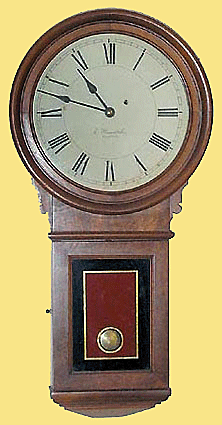 Talk
to antique clock collectors or dealers or repairers about E. Howard &
Company’s clocks, and they’ll all agree that Edward Howard put quality
first. Howard was a Boston area clockmaker who struggled to keep various
clock and watchmaking enterprises afloat during the 19th century and
never compromised quality for profits. Talk
to antique clock collectors or dealers or repairers about E. Howard &
Company’s clocks, and they’ll all agree that Edward Howard put quality
first. Howard was a Boston area clockmaker who struggled to keep various
clock and watchmaking enterprises afloat during the 19th century and
never compromised quality for profits.
Today, Howard’s clocks are often known as the Cadillac of clocks because
he machined them so well and so accurately. With a Howard clock, you get
what you pay for. Generally, prices for his clocks run into four figures
or higher.
The Beginnings
Howard established his reputation with high-grade weight-driven wall
timepieces and regulators. In clockspeak, a "timepiece" is a time-only
device, with no striking mechanism. A "regulator" is a timepiece with an
extremely accurate movement made with superior materials. Howard’s
clocks are just that.
He designed his high quality regulators to compensate for expansion and
contraction of wood and metal components that would otherwise cause a
clock to run too fast or too slow when the weather changed. In fact,
Howard’s regulators were so good, they were used for setting other
clocks—thus the name—for dispatching trains, and for maintaining time at
astronomical observatories. While many people call long-drop pendulum
wall clocks regulators, and the word "Regulator" may even appear on the
case, they don't generally meet the rigorous specification of Howard
regulators, which were known for having variations of less than 10
seconds per month.
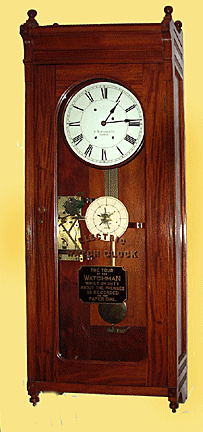 Though
Howard clocks most often seen for sale today are the smaller wall clocks
and regulators, but they are by no means the only ones manufactured by
Howard's companies. He also produced tower clocks, sidewalk clocks, tall
case or grandfather clocks, and mantel clocks. His companies also made
watch clocks used by security guards to record visits to specific
locations, and program clocks for schools and factories, which needed to
ring bells at pre-determined times. Though
Howard clocks most often seen for sale today are the smaller wall clocks
and regulators, but they are by no means the only ones manufactured by
Howard's companies. He also produced tower clocks, sidewalk clocks, tall
case or grandfather clocks, and mantel clocks. His companies also made
watch clocks used by security guards to record visits to specific
locations, and program clocks for schools and factories, which needed to
ring bells at pre-determined times.
Describing his own penchant for perfection Howard said, "Workmen who
left me or who were discharged, complained that I was exacting and
expected the impossible, because I would not tolerate a botch of any
kind. They couldn’t understand that the clock was the end I sought, that
I would give everything I possessed, even life itself, to see all work
out as I had planned."
With a passion for exactness and experimentation along with a history of
financial difficulties, Howard never became one of the giants of
American clockmaking like Seth Thomas. Today, he's better known by many
people for his watches than for his clocks. In his lifetime he was best
known as a maker of scales and balances. But thanks to a good teacher
and a commitment to quality, the clocks he made survived the test of
time.
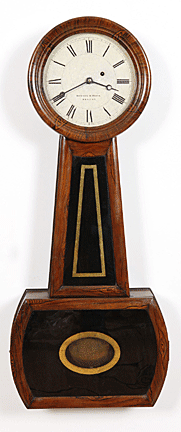 His
teacher was Aaron Willard Jr., the youngest of the four famous
clockmaking brothers in the Willard family. Edward Howard's father died
when he was 12 years old. At that time Howard left to help support the
family. After two years working with his uncle, a wheelwright and plow
manufacturer, Howard spent two years mackerel fishing. In 1829, at the
age of 16, he went to Roxbury, Massachusetts, to begin a five-year
apprenticeship in Willard's shop. His
teacher was Aaron Willard Jr., the youngest of the four famous
clockmaking brothers in the Willard family. Edward Howard's father died
when he was 12 years old. At that time Howard left to help support the
family. After two years working with his uncle, a wheelwright and plow
manufacturer, Howard spent two years mackerel fishing. In 1829, at the
age of 16, he went to Roxbury, Massachusetts, to begin a five-year
apprenticeship in Willard's shop.
Besides instructing his apprentices instruction in the making of clock
movements, he also taught them cabinetmaking so they could make cases as
well. A fellow apprentice with Howard was David Porter Davis, the man
who later became his business partner making clocks under the name
Howard & Davis. While still working for Willard, handcrafting clock
parts, the. two planned how they could automate the process and make
certain parts by machine.
Howard went into business in the early 1840s, making clocks and balances
with his partners, David P. Davis and Luther S. Stephenson. The group
established a factory at Roxbury, a suburb of Boston, in 1845. Two years
later Stephenson left the company and the firm became Howard & Davis.
Howard's Watch and Clock Companies
In 1850 Howard formed the Boston Watch Company with Aaron L. Dennison.
While Howard pursued the perfect watch and a factory that made use of
the concept of interchangeable parts, Davis remained heavily involved
with clock production and other sideline businesses. Beset by financial
problems, the companies were forced to reorganize. By 1859 they had
restructured as E. Howard & Co. Over the years continuing financial
difficulties caused further reorganization with the company name
changing to The Howard Clock and Watch Co., The Howard Watch and Clock
Company, B. Howard Watch and Clock Company, E. Howard Clock Company, and
finally, Howard Clock Products Inc., established in 1911 and which
remains in business today.
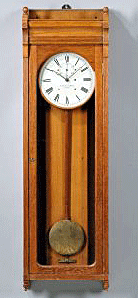 While
the name was changing on the product catalogs, the names on the clocks
themselves remained more constant. Prior to the formation of E Howard &
Company in While
the name was changing on the product catalogs, the names on the clocks
themselves remained more constant. Prior to the formation of E Howard &
Company in
1859, Howard marked his clocks "Howard & I Davis, Boston." From that
point forward, he used E. Howard & Company, Boston" on the dials and
movements to identify his clocks. Howard clocks are also found with
dials bearing the names of dealers or specific buyers, and some original
dials have no name at all. Two names associated with Howard clocks and
found on dials are those of William Riggs, a Philadelphia sales agent
for Howard, and Webb C. Ball, a Cleveland jeweler who developed an
inspection system for railroad clocks and watches known as Ball's
Standard.
The various models of Howard clocks are identified and referred to by
their model numbers, for example a No. 70. or a No. 10. Sometimes,
Howard gave clocks with approximately the same look but in different
sizes separate model numbers, but sometimes not.
Howard
Wall Clocks
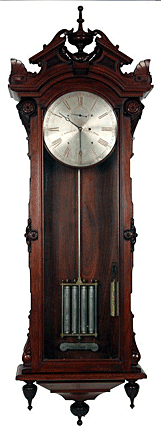 Most
Howard wall clocks have wooden cases constructed from a variety of woods
including black walnut, oak, mahogany and cherry, the latter often
stained to look like rosewood. Case styles range from the simple lines
of the figure eights and banjos to the elaborate carving typical of the
Victorian era. Some models have cases made of marble. Howard marketed
these in the company catalogs for use in public spaces, touted for their
ease of keeping clean since they had no glass. Most
Howard wall clocks have wooden cases constructed from a variety of woods
including black walnut, oak, mahogany and cherry, the latter often
stained to look like rosewood. Case styles range from the simple lines
of the figure eights and banjos to the elaborate carving typical of the
Victorian era. Some models have cases made of marble. Howard marketed
these in the company catalogs for use in public spaces, touted for their
ease of keeping clean since they had no glass.
Though some parts were interchangeable and probably made in advance,
Howard made most clocks to order: A model number categorizes a clock by
general shape- and a specific size of case, movement and dial. A clock
case for a particular model could be made from different types of wood
with variations in decorative moldings and styling of glass tablets.
Dials might be enameled zinc or other metals, silvered electroplate,
marble or even over zinc on some of his earliest clocks. The weight of a
Howard dock usually had the model number cast in the metal.
Collecting Howard Clocks
Clock prices for Howard clocks can vary widely for the same model
because of condition, competition, and the desire of individual buyers
for a particular item. Though Howard made some models of his clocks over
many decades, an older Howard regulator isn’t necessarily better. Size
matters in the clock world. Larger clocks have higher prices than
smaller ones. But condition trumps size.
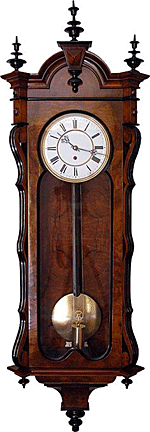 Collectors
look for Howard clocks with a case that retains its original finish and
has no apparent structural damage, original dial with minimal signs of
wear and original hands, a signed movement with no broken parts,
original glass, and a readable original label. Collectors
look for Howard clocks with a case that retains its original finish and
has no apparent structural damage, original dial with minimal signs of
wear and original hands, a signed movement with no broken parts,
original glass, and a readable original label.
In fact, most Howard clocks for sale today have had repairs of one sort
or another. A clock that has been around for 100 years or more and has
been used is bound to show wear. Like all mechanical devices, clocks
require basic maintenance such as oiling.
Proper maintenance necessitates disassembly and handling, two quick ways
to add a bit more wear to an old clock.
People value clocks for different reasons and this too affects price.
Collectors can be motivated by an interest in history or decorative art
as well as the mechanical nature of a Howard clock.
<
Back to Antiques Archives
Next Article > |
